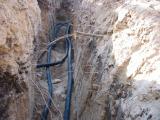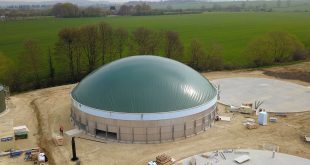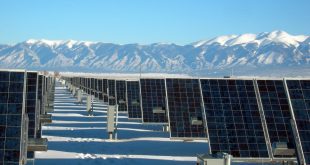There are 4 different types of geothermal heat pumps available today.
Each one has a different method of connecting to the heating distribution system in your home or building. Some types are more efficient than others at delivering space conditioning to the building, but that is a property of the distribution.
All of these GSHP types still get their energy from the ground loop, which transfers the absorbed heat into the internal refrigerant loop. It’s what happens to the heat after that is what makes the difference between types.
The four different types of geothermal heat pumps are water to air, water to water, combo and split heat pumps.
Water to Air
The first and probably most used geothermal heat pump is the water to air heat pump. This heat pump is used for houses with forced air systems, and basically replaces a traditional furnace. The ground loop brings in absorbed heat to the refrigerant loop (the water portion of “water to air”). That refrigerant is then compressed and cycled in front of a fan coil unit to be sent through duct work distribution to the house (the air portion of “water to air”. This process can also be switched in reverse to provide cooling to a structure.
One possible design issue is the sizing of the ductwork. Because geothermal systems are considered a low temp heat source, a higher volume of air is needed to deliver the same heating or cooling load. This will either require larger ductwork to accommodate for the greater air volume, or a specialized, small-duct, high-velocity forced air system like Unico or SpacePak.
Water to Water
The second type is a water to water, or hydronic. This type functions the same as all other heat pumps on the ground loop side of the refrigerant, but instead of sending the compressed and heated refrigerant to a fan coil, it is transferred directly into another water loop that circulates through the heat pump, and into the water-based distribution. This hydronic distribution is most commonly radiant heat (Radiant and Geothermal Article), but it can also be used in conjunction with a domestic hot water or a outside snow melt system.
Combo
The third type is a combo unit. This combines the previous two heat pumps, providing both forced air and hydronic distribution. This is perfect in homes or buildings where both types of distribution are needed. Some zones may be very high heat loss, such as rooms with big windows, or near an exit door that is constantly open, and will require more heat in the space than just radiant or just forced air could provide. This is where a combo unit delivering both could come in very handy.
The last type of pump on the market is known as a split heat pump. This type is basically the same as a regular heat pump on the water side, but it sends the refrigerant in a long loop to a remote air handler. This makes it easier in larger jobs to keep the geothermal unit in the mechanical room with all the loop field connections, and still have an air handler delivering heat to a hard to reach place, such as the second story of a large house. This allows for greater flexibility in the overall design of the heating distribution system.
 Alternative Energy HQ solar power for homes, wind energy, and bio fuel issues
Alternative Energy HQ solar power for homes, wind energy, and bio fuel issues








